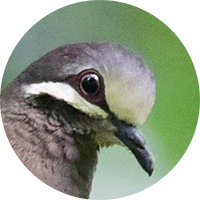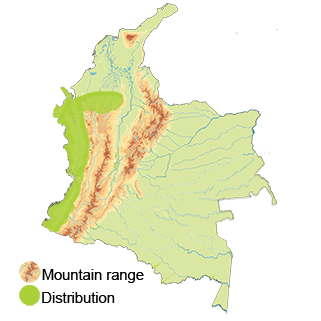Olive-back Quail-dove
The Olive-backed Quail-dove (Leptotrygon veraguensis). Read in Spanish
Appearance: The Olive-backed Quail-dove is a medium-sized dove with a distinctive appearance. It has an olive-green back, reddish-brown wings, a gray head, and a pinkish belly. The male and female Olive-backed Quail-doves are fairly similar in appearance, with the male typically being slightly larger and more brightly colored.
Habitat: The Olive-backed Quail-dove is typically found in dense, lowland tropical forests and forest edges. These birds prefer habitats with dense undergrowth where they can forage for seeds, fruits, and insects. The Olive-backed Quail-dove can be found in a variety of lowland habitats, including tropical rainforests, montane forests, and foothill forests.
Behavior: Olive-backed Quail-doves are often shy and elusive birds that tend to forage on the forest floor or low vegetation. They are known for their soft, low cooing calls that can be heard throughout the day. These doves are primarily ground-dwelling birds but will also roost and nest in trees or dense shrubs.
Breeding: During the breeding season, Olive-backed Quail-doves engage in courtship displays that involve vocalizations and various behaviors to attract mates. The female typically builds a simple nest of twigs and leaves in the vegetation, where she lays a small clutch of eggs. Both parents share the incubation and care of the young doves.
Conservation Status: The conservation status of the Olive-backed Quail-dove is considered to be of least concern.
Distribution
The Olive-backed Quail-dove (Leptotrygon veraguensis)
Pacific Region: The Pacific Region of Colombia, including areas like Chocó and Valle del Cauca, is known to host populations of the Olive-backed Quail-dove. These birds are found in the dense, humid forests along the Pacific coast.
Andean Region: In the western and north central Andean foothills and montane forests, the Olive-backed Quail-dove can be spotted. These birds thrive in the diverse ecosystems present in the Andean mountain range.
Caribbean Region: While less common, some populations of the Olive-backed Quail-dove may also be found in the Caribbean Region of Colombia, particularly in the forests along the northern coast and the Sierra Nevada de Santa Marta mountain range.
Taxonomy
The Olive-back Quail-dove (Leptotrygon veraguensis
- Kingdom: Animalia
- Phylum: Chordata
- Class: Aves (Birds)
- Order: Columbiformes
- Family: Columbidae
- Genus: Leptotrygon
- Species: Leptotrygon veraguensis
Vocalization
The Olive-backed Quail-dove (Leptotrygon veraguensis)
- Call: The primary vocalization of the Olive-backed Quail-dove is a soft, low-pitched cooing sound that is repetitive and rhythmic. This call is typically heard throughout the day, especially during the early morning and evening hours. The call of the Olive-backed Quail-dove is often described as a series of mournful, melodious coos that carry through the forest understory. It helps individuals maintain contact with each other and establish territories.
- Courtship Vocalizations: During the breeding season, Olive-backed Quail-doves engage in courtship displays that involve vocalizations. Males may produce more elaborate and prolonged cooing sounds to attract females and establish their presence. Courtship vocalizations may involve variations in pitch, rhythm, and intensity to communicate readiness to mate and strengthen pair bonds.
- Alarm Calls: When threatened or disturbed, Olive-backed Quail-doves may emit sharp, high-pitched alarm calls to warn others in the vicinity of potential danger. These alarm calls serve as a means of communication within the group or pair to coordinate responses to threats.
- Contact Calls: Apart from their main cooing call, Olive-backed Quail-doves may also use softer contact calls to maintain communication within a pair or group. These contact calls help individuals stay in touch when foraging or moving through the dense vegetation of their habitat.




